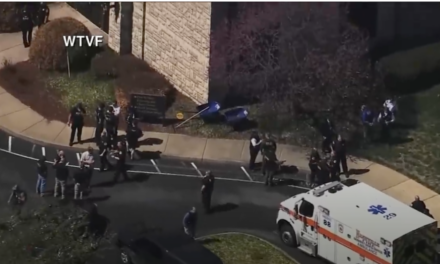We support our Publishers and Content Creators. You can view this story on their website by CLICKING HERE.
When “Mad Max: Fury Road” came out in 2015, it was met with a furious reception from audiences, in part due to the culture war battles surrounding it.
A handful of men’s rights activist bloggers found the film’s content disagreeable and questioned the fact that director George Miller had brought “Vagina Monologues” writer Eve Ensler in as a consultant to discuss the feminist implications of the film. Others criticized the downplaying of the titular Max character with the addition of the new character Furiosa and the removal of Mel Gibson from the starring role.
The film nominally underperformed — grossing $154.3 million domestically and $226.1 million abroad on a budget upwards of $150 million — yet firmly cemented itself as one of the most critically acclaimed films of the 2010s and one of the greatest action movies of all time.
Nine years later, “Furiosa: A Mad Max Saga,” a prequel to Miller’s most recent “Fury Road” film, has been met with a similar box office and culture war battle. The film’s reviews are glowing, but its opening weekend was a disaster, as it became the worst Memorial Day box office in 43 years — grossing the film $32 million domestically and $33 million abroad.
Twitter has been lively with discussions about why the film is bombing. Conservative movie fans are buzzing as to whether the film failed because audiences don’t like female-led action films or because fans seem to think it is bad going into it. Besides actual criticism of the film, audiences possibly aren’t willing to shill the average cost of $68.73 to take a family of four to the movies. Movies are also shifting to streaming services more quickly in a post-Covid world, leading to a decline in box office revenue. There seems to be a general and growing disinterest in blockbusters and sequels.
“Furisoa: A Mad Max Saga” is undeniably flawed compared to its predecessor. Its special effects look worse, its performances are weaker, and the lengthy runtime makes it drag. However, the movie’s vignettes, excellent action scenes, great lead performance by Anya Taylor-Joy, and a solid spiritual core hold it together. That said, it is certainly understandable why apprehensive audiences would be nervous to give it a chance.
Whether it is a backlash against strong female leads or overall negative industry trends, audiences are seemingly disinterested in a fifth “Mad Max” film.
These discussions are curious when you take the film itself into question, as “Furiosa” is arguably less political than its predecessor. George Miller is not shy about his politics. His atheism, anti-racism, environmentalism, and class sentiments are all heavy-handed in films like “Happy Feet,” “Babe: Pig in the City,” and “Three Thousand Years of Longing.” The recent “Mad Max: Fury Road” was explicitly a story about how men and women need to work together as equals to combat the evils of a domineering capitalist patriarchy, embodied by the entitled and cruel warlord Immortan Joe.
“Furiosa,” despite being far more ambitious and larger in scope, has a narrower purpose. It is a revenge epic in line with films like “Ben-Hur” and “Kill Bill.” It leaves many of the direct sociopolitical implications of the wasteland to the side in favor of a story about the spiritual degradation of this world.
Its only major digression into politics comes in the form of its villain Dementus, the wannabe populist tyrant who marches under red banners and gives lofty speeches about liberating the wasteland, yet clearly is a power-mongering monster. His is almost a critique of the sort of revolutionary politics of the left, portraying leaders like him as Stalinist or Napoleonic, who care more about themselves than the revolution.
The wasteland is a metaphor for the brutality of the human psyche. Much like the infamous island in “The Lord of the Flies,” it is a place where the human being is reduced to his deepest survival instincts. All pretense of civilization breaks down, and the thing that survives is the brutal animal within every man. Each “Mad Max” film grapples with the question of what human beings do when pushed to the limits of survival. The first film showed a man being driven to the point of catatonic insanity by the pain of watching his wife and children being senselessly murdered, and each film grapples with similar brutality and harshness.
If there’s any narrative thread connecting the five “Mad Max” films, it is the question of hope and grace. There is very little connective tissue between the entries, beyond being set in Australia. Each feels disconnected and more radical than the last, lacking a cohesive narrative but each becoming closer to its core idea. “Mad Max: Fury Road” most clearly delivered on this, combining the dissociative nature of its titular character with an immensely creative and insane world around him.
Paradoxically, the franchise has always been at its best when the brutal realities of human nature are peppered with moments of grace and mercy. Max, Furiosa, and the others are constantly grappling with the thin strand of hope for the future that keeps them alive, and wrestle internally with what the wasteland is doing to their souls. Even when evil characters take advantage of others’ mercy, there is still a moral question implicit in what they’re willing to let themselves devolve into — and whether they can dig themselves out of it.
“Furiosa” tackles this theme from its opening frames, showing a young Furiosa reaching for a forbidden fruit in the paradise of the “Green Place.” Drawing on the Biblical metaphor, she is kidnapped from her metaphorical Eden and forced to adhere to the standards of the world around her, adapting to a world of violence and cruelty. But as she realizes, this descent draws her into the same evils that those around her inflict on the poor and innocent.
Early in the film, her mother gives her a seed to one of the fruits of the “Green Place,” which she ties to her hair and keeps with her as a reminder of the hope that she may be able to return to her homeland in the future. She carries her literal seed of hope on her person, and we come to see in the movie how this seed sprouts into something profound and lasting going into the next movie.
The scene retroactively sets up “Mad Max: Fury Road” as a story of fulfillment. The adult Furiosa in that film says she is looking for redemption, and “Furiosa” tells us that the redemption she seeks is a personal one from the depths of hatred and wrath to which she allowed herself to descend. All good revenge stories are ultimately anti-revenge stories because revenge is an evil that poisons the soul. “Furiosa” understands this brilliantly and mostly succeeds in capturing the eternal tension between hope, grace, and human nature that makes up the dance of this goofy action franchise.
Tyler Hummel is a Nashville-based freelance journalist, a College Fix Fellow, and a member of the Music City Film Critics Association. He has contributed to The Dispatch, The New York Sun, Hollywood in Toto, The Pamphleteer, Law and Liberty, Main Street Nashville, North American Anglican, Living Church, and Geeks Under Grace.

 Conservative
Conservative  Search
Search Trending
Trending Current News
Current News 





